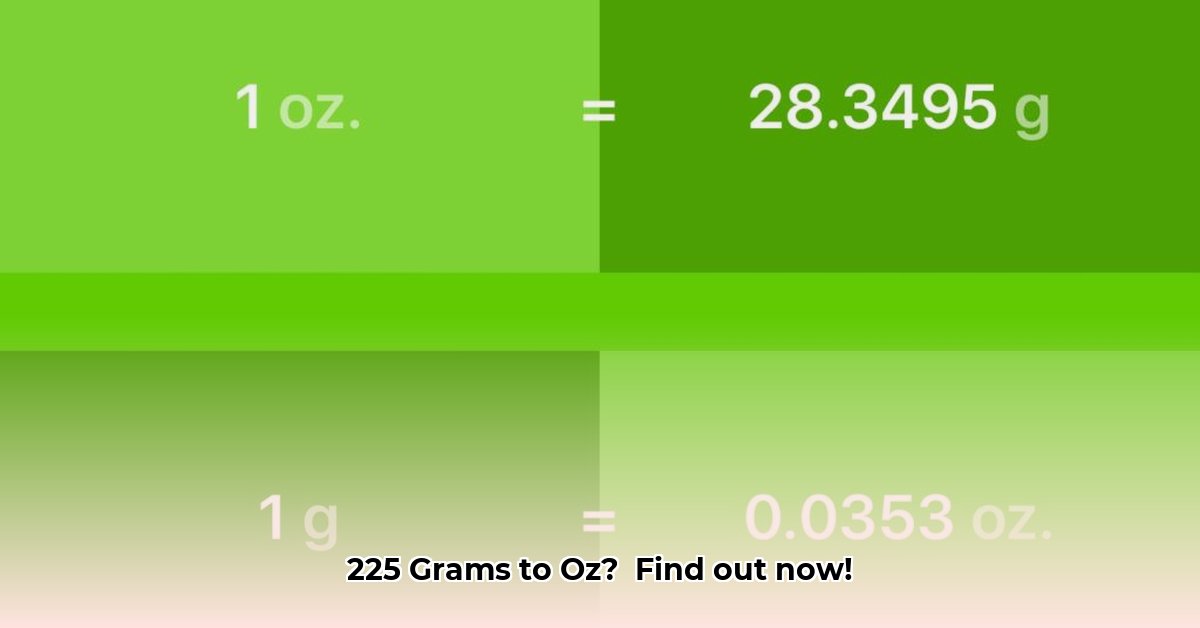
Understanding the Conversion: Grams to Avoirdupois Ounces
Converting 225 grams to ounces requires understanding the nuances of measurement systems. This guide provides a step-by-step approach to accurate conversion, emphasizing the importance of using the correct type of ounce. We'll explore the process, address potential ambiguities, and illustrate its practical applications.
The Importance of Specifying "Ounce"
Before we begin, it's crucial to understand that "ounce" isn't a single, universally defined unit. While the term is relatively familiar, there are variations, with the avoirdupois ounce being the most commonly used in everyday contexts, particularly in cooking and general weighing. Other types exist, such as the troy ounce (used for precious metals), but we'll focus on the avoirdupois ounce for this conversion. Misunderstanding this can lead to significant inaccuracies. Therefore, always clarify which type of ounce is intended when dealing with conversions.
Step-by-Step Conversion: 225 Grams to Ounces
Here's a clear, step-by-step guide to converting 225 grams to avoirdupois ounces:
Identify the Conversion Factor: The fundamental relationship is 1 gram ≈ 0.035274 ounces (avoirdupois). This factor allows us to translate between gram and ounce measurements.
Perform the Calculation: Multiply the number of grams (225) by the conversion factor: 225 grams * 0.035274 oz/gram ≈ 7.93675 ounces.
Round Appropriately: The precision needed dictates rounding. For most everyday purposes, rounding to 7.94 ounces provides sufficient accuracy. However, for applications demanding higher precision (e.g., scientific experiments or pharmaceuticals), retaining more decimal places might be necessary.
Addressing Ambiguity and Potential Errors
The seemingly simple conversion of 225 grams to ounces can yield slightly different results based on the precision of the conversion factor and rounding procedures. Understanding these potential sources of error is critical for ensuring accuracy in your calculations.
The Impact of Rounding and Precision
Using different levels of precision in the conversion factor will produce slightly varied results. Consider the following table:
| Conversion Factor (oz/gram) | Result (ounces) | Rounded (2 Decimal Places) |
|---|---|---|
| 0.035274 | 7.93665 | 7.94 |
| 0.035 | 7.875 | 7.88 |
As shown, even small alterations in the conversion factor can affect the final result, especially if you're rounding aggressively.
Practical Applications: Where Accuracy Matters
Precise gram-to-ounce conversions are essential in various fields:
- Culinary Arts: Many recipes, particularly those of international origin, use grams; precise conversion ensures consistent results.
- Pharmaceuticals: Accurate dosage is paramount; the slightest inaccuracy can have dangerous consequences.
- Engineering and Manufacturing: Precision is vital for ensuring components fit correctly and equipment functions properly.
Conclusion: Mastering Gram-to-Ounce Conversions
Mastering gram-to-ounce conversion involves not only performing calculations but also understanding the nuances of measurement systems, handling precision, and appropriately rounding results. Always specify the type of ounce (typically avoirdupois for everyday use), use a reliable conversion factor, and round to a precision appropriate for the task at hand. This approach ensures accuracy and avoids potential errors. While online converters can be helpful, always double-check their outputs, especially for critical applications.
Resources: Reliable Online Converters and Further Reading
For additional information on unit conversion and measurement systems, refer to reputable sources such as the NIST (National Institute of Standards and Technology) website. While online converters provide convenience, they should be used with caution and complemented by a solid understanding of the underlying principles. Relying solely on online converters without understanding the calculation risks significant inaccuracy.